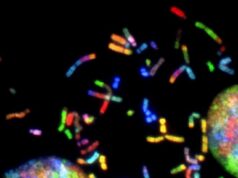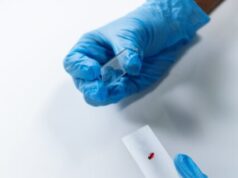Electron micrograph of C. jejuni in chicken gut. Credit: Griffith University
A team at Griffith’s Institute for Glycomics identified a unique sensory structure that is able to bind host-specific sugar and is present on particularly virulent strains of Campylobacter jejuni.
In their paper A direct-sensing galactose chemoreceptor recently evolved in invasive strains of Campylobacter jejuni published in Nature Communications this week, the team explain that the ability to cause disease depends on the ability of bacterial cells to move towards their target host cells.
This movement is determined by specialised structures on the bacterial cells called sensory receptors that sense chemicals in their environment.
It is the first known finding of a bacterial sensor that can bind sugar directly.
Campylobacter bacteria are now well recognised as one of the most common cause of food borne enteritis and have surpassed other food bugs such as Salmonella and Shigella as causes of illness, hospitalisation and of lost production in the workplace. The campylobacter infection is usually passed to humans from food animals, particularly poultry, through consumption of undercooked meats, unpasteurised milk and contaminated water.
Find your dream job in the space industry. Check our Space Job Board »
The researchers used chicken models to look at the mutant displays with disabled CcrG sensor and determined that disabling just this one sensor reduces the ability of campylobacteria to colonise chickens.
“This is a very important finding as sensory structures are very specific to each bacteria and offer high target specificity for design of new antimicrobial compounds,” says research leader Professor Victoria Korolik.
“Essentially it should be possible to design an antimicrobial drug to target a specific pathogen that will not affect normal flora”.
“Targeting sensory apparatus of microbes also reduces risk of development of antimicrobial resistance, since the bacterial cell will not be killed, but rather, have its ability to reach host cells and cause disease, disabled.”
“In addition, getting an understanding of how bacterial sensors bind to chemicals has enormous potential for the future. With understanding will come the ability to engineer bacteria with a set of sensors that will selectively direct cancer-killing bacteria toward cancer cells or direct bacteria that degrade chemicals in environmental contamination, such as oil spills to the contaminated areas.”
Institute director Professor Mark von Itzstein said Professor Korolik’s progress added to the outstanding efforts being made across the whole institute.
“Our researchers are leading innovation in medicine with promising new drugs and vaccines and solutions to improve patient outcomes and reduce unnecessary healthcare complications,” he said.
Source: Griffith University
Research Reference:
Christopher J. Day et al. A direct-sensing galactose chemoreceptor recently evolved in invasive strains of Campylobacter jejuni, Nature Communications (2016). DOI: 10.1038/ncomms13206











